RSCP7004, Summer 2019: Impact of ICT on Quality of Care Report
VerifiedAdded on 2022/11/26
|21
|5570
|118
Report
AI Summary
This report investigates the impact of Information and Communication Technology (ICT) on the quality of care in healthcare settings. It begins with an introduction to the conceptual background, research aims, objectives, and questions. The literature review delves into the concept of ICT, its role in modern healthcare, and its influence on patient safety, access to services through telemedicine, and evolving models of care based on telemonitoring. The research methodology outlines the interpretivism philosophy, inductive approach, descriptive research design, and literature review strategy, including data collection and analysis methods. The report also addresses ethical considerations and provides a time and cost frame for the research. The findings emphasize how ICT, including telemedicine and e-health applications, enhances patient safety, improves access to care, and transforms healthcare delivery models. The report highlights the importance of ICT in bridging data gaps, improving efficiency, and averting medical errors within the healthcare sector.

Running head: QUALITY OF CARE
Impact of ICT on Quality of
Care
July 16
2019
Impact of ICT on Quality of
Care
July 16
2019
Paraphrase This Document
Need a fresh take? Get an instant paraphrase of this document with our AI Paraphraser
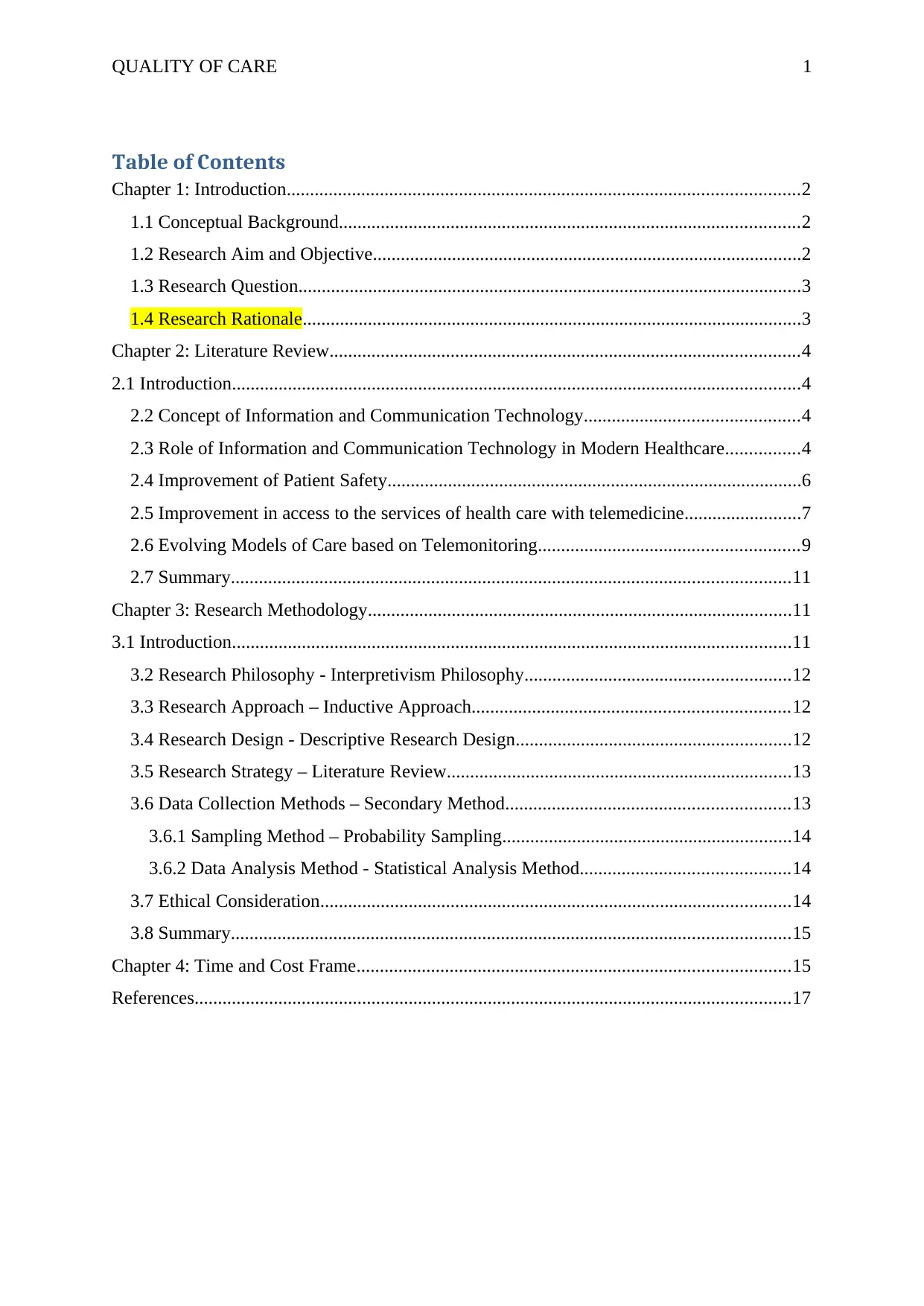
QUALITY OF CARE 1
Table of Contents
Chapter 1: Introduction..............................................................................................................2
1.1 Conceptual Background...................................................................................................2
1.2 Research Aim and Objective............................................................................................2
1.3 Research Question............................................................................................................3
1.4 Research Rationale...........................................................................................................3
Chapter 2: Literature Review.....................................................................................................4
2.1 Introduction..........................................................................................................................4
2.2 Concept of Information and Communication Technology..............................................4
2.3 Role of Information and Communication Technology in Modern Healthcare................4
2.4 Improvement of Patient Safety.........................................................................................6
2.5 Improvement in access to the services of health care with telemedicine.........................7
2.6 Evolving Models of Care based on Telemonitoring........................................................9
2.7 Summary........................................................................................................................11
Chapter 3: Research Methodology...........................................................................................11
3.1 Introduction........................................................................................................................11
3.2 Research Philosophy - Interpretivism Philosophy.........................................................12
3.3 Research Approach – Inductive Approach....................................................................12
3.4 Research Design - Descriptive Research Design...........................................................12
3.5 Research Strategy – Literature Review..........................................................................13
3.6 Data Collection Methods – Secondary Method.............................................................13
3.6.1 Sampling Method – Probability Sampling..............................................................14
3.6.2 Data Analysis Method - Statistical Analysis Method.............................................14
3.7 Ethical Consideration.....................................................................................................14
3.8 Summary........................................................................................................................15
Chapter 4: Time and Cost Frame.............................................................................................15
References................................................................................................................................17
Table of Contents
Chapter 1: Introduction..............................................................................................................2
1.1 Conceptual Background...................................................................................................2
1.2 Research Aim and Objective............................................................................................2
1.3 Research Question............................................................................................................3
1.4 Research Rationale...........................................................................................................3
Chapter 2: Literature Review.....................................................................................................4
2.1 Introduction..........................................................................................................................4
2.2 Concept of Information and Communication Technology..............................................4
2.3 Role of Information and Communication Technology in Modern Healthcare................4
2.4 Improvement of Patient Safety.........................................................................................6
2.5 Improvement in access to the services of health care with telemedicine.........................7
2.6 Evolving Models of Care based on Telemonitoring........................................................9
2.7 Summary........................................................................................................................11
Chapter 3: Research Methodology...........................................................................................11
3.1 Introduction........................................................................................................................11
3.2 Research Philosophy - Interpretivism Philosophy.........................................................12
3.3 Research Approach – Inductive Approach....................................................................12
3.4 Research Design - Descriptive Research Design...........................................................12
3.5 Research Strategy – Literature Review..........................................................................13
3.6 Data Collection Methods – Secondary Method.............................................................13
3.6.1 Sampling Method – Probability Sampling..............................................................14
3.6.2 Data Analysis Method - Statistical Analysis Method.............................................14
3.7 Ethical Consideration.....................................................................................................14
3.8 Summary........................................................................................................................15
Chapter 4: Time and Cost Frame.............................................................................................15
References................................................................................................................................17

QUALITY OF CARE 2
Chapter 1: Introduction
1.1 Conceptual Background
The combination of information and communication technology tools with the medical
practice results not just in creating opportunities in relation to increasing accessibility of
services and enhanced quality of the services but it also results in the transformation of the
care delivery model. Increasing utilization of computer applications in the healthcare segment
is driven by the rising citizen’s expectations related to the quality of medical care
(Frontenders, 2016). Besides this, the modern system of healthcare majorly depends on the
notions of patient’s empowerment, service continuity, and shared care. Meeting these
requirements could be possible by introducing a well-developed e-health environment which
enables safe contacts through “electronic medium” between patients and physicians. In
return, the utilization of the telemedical applications enhances the procedure of the exchange
of information between the specialists demonstrating diverse referential stages and extents of
medicine. The increasing awareness related to the fact that the errors in the medical sector are
the cause of mortality and morbidity has resulted in increasing the search for effective
countermeasures (Rouleau, Gagnon and Cote, 2015). The utilization of information and
communication technology is considered as the most effective therapies. The intent of this
paper is to explore the impact of information and commination technology in the quality of
care.
1.2 Research Aim and Objective
The research aims to identify the impact of information and communication technology on
the quality of care. In order to achieve this aim, the researcher has framed some of the
objectives that are presented below:
Chapter 1: Introduction
1.1 Conceptual Background
The combination of information and communication technology tools with the medical
practice results not just in creating opportunities in relation to increasing accessibility of
services and enhanced quality of the services but it also results in the transformation of the
care delivery model. Increasing utilization of computer applications in the healthcare segment
is driven by the rising citizen’s expectations related to the quality of medical care
(Frontenders, 2016). Besides this, the modern system of healthcare majorly depends on the
notions of patient’s empowerment, service continuity, and shared care. Meeting these
requirements could be possible by introducing a well-developed e-health environment which
enables safe contacts through “electronic medium” between patients and physicians. In
return, the utilization of the telemedical applications enhances the procedure of the exchange
of information between the specialists demonstrating diverse referential stages and extents of
medicine. The increasing awareness related to the fact that the errors in the medical sector are
the cause of mortality and morbidity has resulted in increasing the search for effective
countermeasures (Rouleau, Gagnon and Cote, 2015). The utilization of information and
communication technology is considered as the most effective therapies. The intent of this
paper is to explore the impact of information and commination technology in the quality of
care.
1.2 Research Aim and Objective
The research aims to identify the impact of information and communication technology on
the quality of care. In order to achieve this aim, the researcher has framed some of the
objectives that are presented below:
⊘ This is a preview!⊘
Do you want full access?
Subscribe today to unlock all pages.

Trusted by 1+ million students worldwide
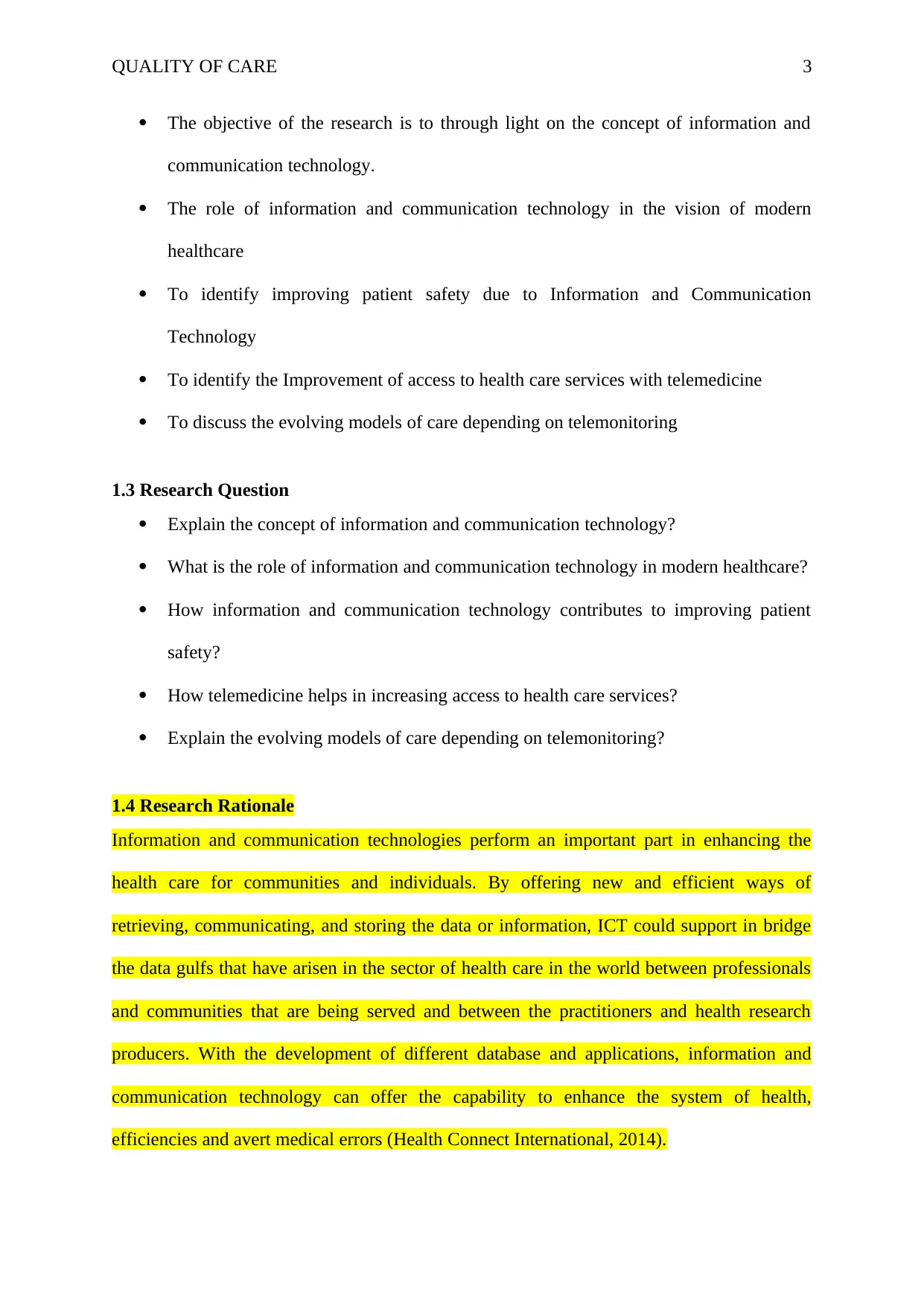
QUALITY OF CARE 3
The objective of the research is to through light on the concept of information and
communication technology.
The role of information and communication technology in the vision of modern
healthcare
To identify improving patient safety due to Information and Communication
Technology
To identify the Improvement of access to health care services with telemedicine
To discuss the evolving models of care depending on telemonitoring
1.3 Research Question
Explain the concept of information and communication technology?
What is the role of information and communication technology in modern healthcare?
How information and communication technology contributes to improving patient
safety?
How telemedicine helps in increasing access to health care services?
Explain the evolving models of care depending on telemonitoring?
1.4 Research Rationale
Information and communication technologies perform an important part in enhancing the
health care for communities and individuals. By offering new and efficient ways of
retrieving, communicating, and storing the data or information, ICT could support in bridge
the data gulfs that have arisen in the sector of health care in the world between professionals
and communities that are being served and between the practitioners and health research
producers. With the development of different database and applications, information and
communication technology can offer the capability to enhance the system of health,
efficiencies and avert medical errors (Health Connect International, 2014).
The objective of the research is to through light on the concept of information and
communication technology.
The role of information and communication technology in the vision of modern
healthcare
To identify improving patient safety due to Information and Communication
Technology
To identify the Improvement of access to health care services with telemedicine
To discuss the evolving models of care depending on telemonitoring
1.3 Research Question
Explain the concept of information and communication technology?
What is the role of information and communication technology in modern healthcare?
How information and communication technology contributes to improving patient
safety?
How telemedicine helps in increasing access to health care services?
Explain the evolving models of care depending on telemonitoring?
1.4 Research Rationale
Information and communication technologies perform an important part in enhancing the
health care for communities and individuals. By offering new and efficient ways of
retrieving, communicating, and storing the data or information, ICT could support in bridge
the data gulfs that have arisen in the sector of health care in the world between professionals
and communities that are being served and between the practitioners and health research
producers. With the development of different database and applications, information and
communication technology can offer the capability to enhance the system of health,
efficiencies and avert medical errors (Health Connect International, 2014).
Paraphrase This Document
Need a fresh take? Get an instant paraphrase of this document with our AI Paraphraser

QUALITY OF CARE 4
Chapter 2: Literature Review
2.1 Introduction
The literature review chapter is also known as narrative review which is a kind of review of
the 1article. A literature review is a scholarly paper that is comprised of a current concept
comprising functional findings, theoretical and methodological contributions to the specific
subject or topic (Ridley, 2012). The literature review chapter is very beneficial and
supportive to the researcher as it provides the perceptions, opinions, and findings of different
authors and researchers presented on a specific topic. This chapter helps the researcher in
presenting current as well as past knowledge and helps in providing the findings of the
research.
2.2 Concept of Information and Communication Technology
According to Zammuto, Griffith and Faraj, (2007), information and communication
technology is the extended term for the information technology that allow integrated
communications and the incorporation of the telecommunications and computers along with
required enterprise software, audio-visual software, and middleware system, that allow
operators to store, spread, and manipulate information. The information and communication
technology is also utilized to refer to the merging of audio-visual and telephone networks
with the networks of the computer by a link system. There are several economic incentives
for merging the network of telephone with the network of a computer system by using a
single combined system of management, signal distribution, and cabling (Kamani, 2015).
2.3 Role of Information and Communication Technology in Modern Healthcare
According to the Royal Society (2006), the healthcare segment is developing from the time
when human beings initiated to adopt conscious actions for disease treatment and preserving
health. The methods depending on the unreasonable opinions or experience of physicians
Chapter 2: Literature Review
2.1 Introduction
The literature review chapter is also known as narrative review which is a kind of review of
the 1article. A literature review is a scholarly paper that is comprised of a current concept
comprising functional findings, theoretical and methodological contributions to the specific
subject or topic (Ridley, 2012). The literature review chapter is very beneficial and
supportive to the researcher as it provides the perceptions, opinions, and findings of different
authors and researchers presented on a specific topic. This chapter helps the researcher in
presenting current as well as past knowledge and helps in providing the findings of the
research.
2.2 Concept of Information and Communication Technology
According to Zammuto, Griffith and Faraj, (2007), information and communication
technology is the extended term for the information technology that allow integrated
communications and the incorporation of the telecommunications and computers along with
required enterprise software, audio-visual software, and middleware system, that allow
operators to store, spread, and manipulate information. The information and communication
technology is also utilized to refer to the merging of audio-visual and telephone networks
with the networks of the computer by a link system. There are several economic incentives
for merging the network of telephone with the network of a computer system by using a
single combined system of management, signal distribution, and cabling (Kamani, 2015).
2.3 Role of Information and Communication Technology in Modern Healthcare
According to the Royal Society (2006), the healthcare segment is developing from the time
when human beings initiated to adopt conscious actions for disease treatment and preserving
health. The methods depending on the unreasonable opinions or experience of physicians
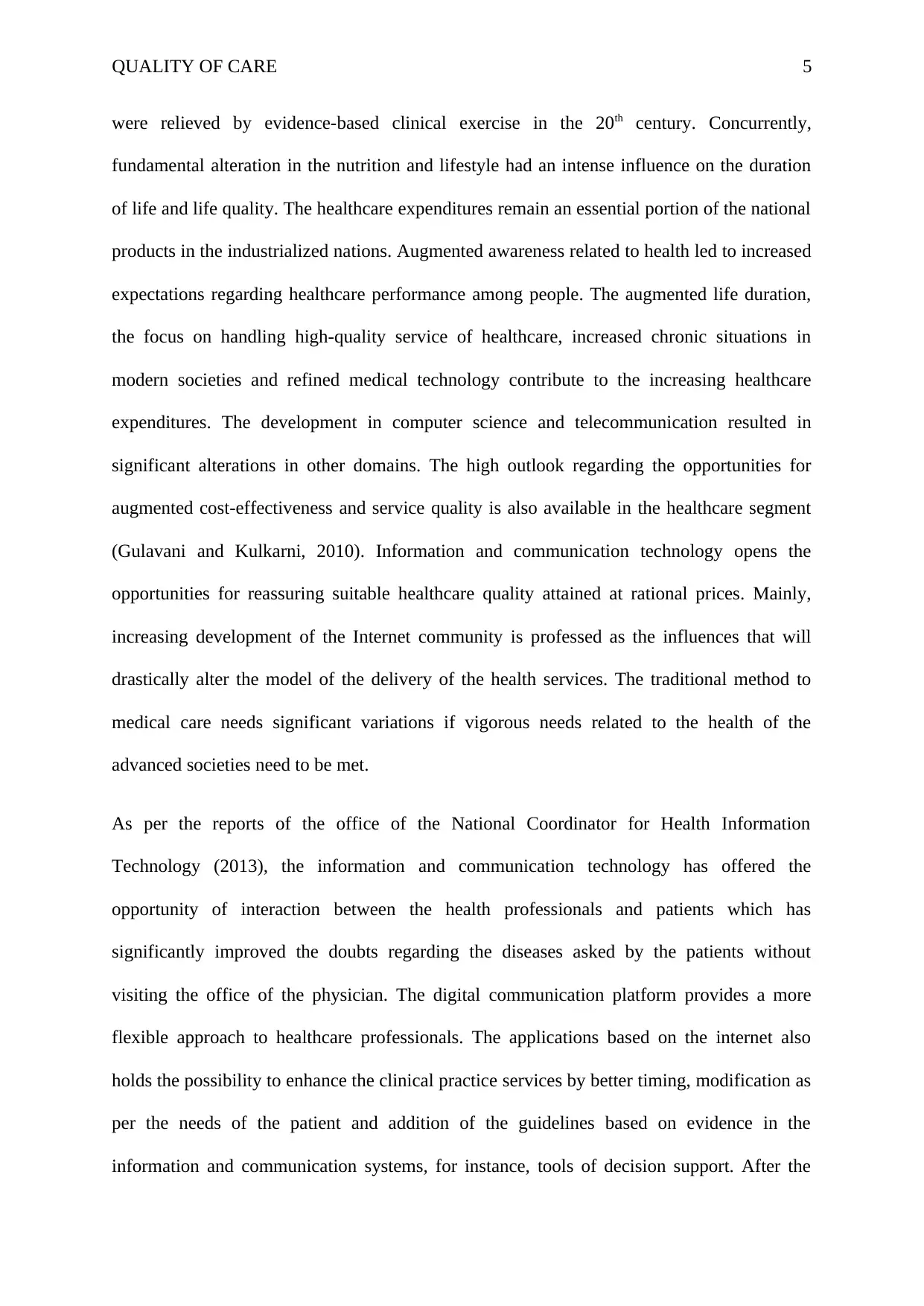
QUALITY OF CARE 5
were relieved by evidence-based clinical exercise in the 20th century. Concurrently,
fundamental alteration in the nutrition and lifestyle had an intense influence on the duration
of life and life quality. The healthcare expenditures remain an essential portion of the national
products in the industrialized nations. Augmented awareness related to health led to increased
expectations regarding healthcare performance among people. The augmented life duration,
the focus on handling high-quality service of healthcare, increased chronic situations in
modern societies and refined medical technology contribute to the increasing healthcare
expenditures. The development in computer science and telecommunication resulted in
significant alterations in other domains. The high outlook regarding the opportunities for
augmented cost-effectiveness and service quality is also available in the healthcare segment
(Gulavani and Kulkarni, 2010). Information and communication technology opens the
opportunities for reassuring suitable healthcare quality attained at rational prices. Mainly,
increasing development of the Internet community is professed as the influences that will
drastically alter the model of the delivery of the health services. The traditional method to
medical care needs significant variations if vigorous needs related to the health of the
advanced societies need to be met.
As per the reports of the office of the National Coordinator for Health Information
Technology (2013), the information and communication technology has offered the
opportunity of interaction between the health professionals and patients which has
significantly improved the doubts regarding the diseases asked by the patients without
visiting the office of the physician. The digital communication platform provides a more
flexible approach to healthcare professionals. The applications based on the internet also
holds the possibility to enhance the clinical practice services by better timing, modification as
per the needs of the patient and addition of the guidelines based on evidence in the
information and communication systems, for instance, tools of decision support. After the
were relieved by evidence-based clinical exercise in the 20th century. Concurrently,
fundamental alteration in the nutrition and lifestyle had an intense influence on the duration
of life and life quality. The healthcare expenditures remain an essential portion of the national
products in the industrialized nations. Augmented awareness related to health led to increased
expectations regarding healthcare performance among people. The augmented life duration,
the focus on handling high-quality service of healthcare, increased chronic situations in
modern societies and refined medical technology contribute to the increasing healthcare
expenditures. The development in computer science and telecommunication resulted in
significant alterations in other domains. The high outlook regarding the opportunities for
augmented cost-effectiveness and service quality is also available in the healthcare segment
(Gulavani and Kulkarni, 2010). Information and communication technology opens the
opportunities for reassuring suitable healthcare quality attained at rational prices. Mainly,
increasing development of the Internet community is professed as the influences that will
drastically alter the model of the delivery of the health services. The traditional method to
medical care needs significant variations if vigorous needs related to the health of the
advanced societies need to be met.
As per the reports of the office of the National Coordinator for Health Information
Technology (2013), the information and communication technology has offered the
opportunity of interaction between the health professionals and patients which has
significantly improved the doubts regarding the diseases asked by the patients without
visiting the office of the physician. The digital communication platform provides a more
flexible approach to healthcare professionals. The applications based on the internet also
holds the possibility to enhance the clinical practice services by better timing, modification as
per the needs of the patient and addition of the guidelines based on evidence in the
information and communication systems, for instance, tools of decision support. After the
⊘ This is a preview!⊘
Do you want full access?
Subscribe today to unlock all pages.

Trusted by 1+ million students worldwide

QUALITY OF CARE 6
first clinical trial provided, it was clear that even severe situations can be professionally
handled or treated at home by executing suitable communication with the patient and proper
nursing of the symptoms and signs through telemedical infrastructure is certain. System of
Teleconferencing could be installed in the home of the patient and utilized by the patient with
complete support of the members of the family or social workers (EH News Bureau, 2019).
2.4 Improvement of Patient Safety
According to the report of the Institute of Medicine, there is an increasing accidents related to
the medical error published in the year 1999. The main issue identified was the medical error
and raised the importance of the proper healthcare services for avoiding these issues and the
requirement of compulsory reporting programs. The data presented by this publication
enabled the estimations regarding the consequences of medical errors on the national level in
the USA. The major shocking data was about comprehension that 98000 deaths yearly may
be associated to the medical errors (Patterson, Cook and Render, 2002). In the year 2001, the
next report was published of the Institute of Medicine, with the title “Crossing the Quality
Chasm”. The report indicated the six motives of enhancement such as effectiveness, equity,
timeliness, safety, patient-centeredness, and efficiency. These motives can be approached
through the application of the tools of information and communication technology. The
optimistic part of technology in reducing the medical error incidences mist result in the wider
utilization of such solutions, such as wireless PDA devices, bar-coding of medication, for the
drug information and access to the records of patients along with the systems for the entry of
the drug order. In all the most negative impact on the healthcare segment, the first three
positions covered by the negative drug events, nosocomial contagions and practical
difficulties.
According to the Office of Disease Prevention and Health Promotion (2019), negative drug
event is said to be the single class of medical errors. Medication errors are accountable for a
first clinical trial provided, it was clear that even severe situations can be professionally
handled or treated at home by executing suitable communication with the patient and proper
nursing of the symptoms and signs through telemedical infrastructure is certain. System of
Teleconferencing could be installed in the home of the patient and utilized by the patient with
complete support of the members of the family or social workers (EH News Bureau, 2019).
2.4 Improvement of Patient Safety
According to the report of the Institute of Medicine, there is an increasing accidents related to
the medical error published in the year 1999. The main issue identified was the medical error
and raised the importance of the proper healthcare services for avoiding these issues and the
requirement of compulsory reporting programs. The data presented by this publication
enabled the estimations regarding the consequences of medical errors on the national level in
the USA. The major shocking data was about comprehension that 98000 deaths yearly may
be associated to the medical errors (Patterson, Cook and Render, 2002). In the year 2001, the
next report was published of the Institute of Medicine, with the title “Crossing the Quality
Chasm”. The report indicated the six motives of enhancement such as effectiveness, equity,
timeliness, safety, patient-centeredness, and efficiency. These motives can be approached
through the application of the tools of information and communication technology. The
optimistic part of technology in reducing the medical error incidences mist result in the wider
utilization of such solutions, such as wireless PDA devices, bar-coding of medication, for the
drug information and access to the records of patients along with the systems for the entry of
the drug order. In all the most negative impact on the healthcare segment, the first three
positions covered by the negative drug events, nosocomial contagions and practical
difficulties.
According to the Office of Disease Prevention and Health Promotion (2019), negative drug
event is said to be the single class of medical errors. Medication errors are accountable for a
Paraphrase This Document
Need a fresh take? Get an instant paraphrase of this document with our AI Paraphraser
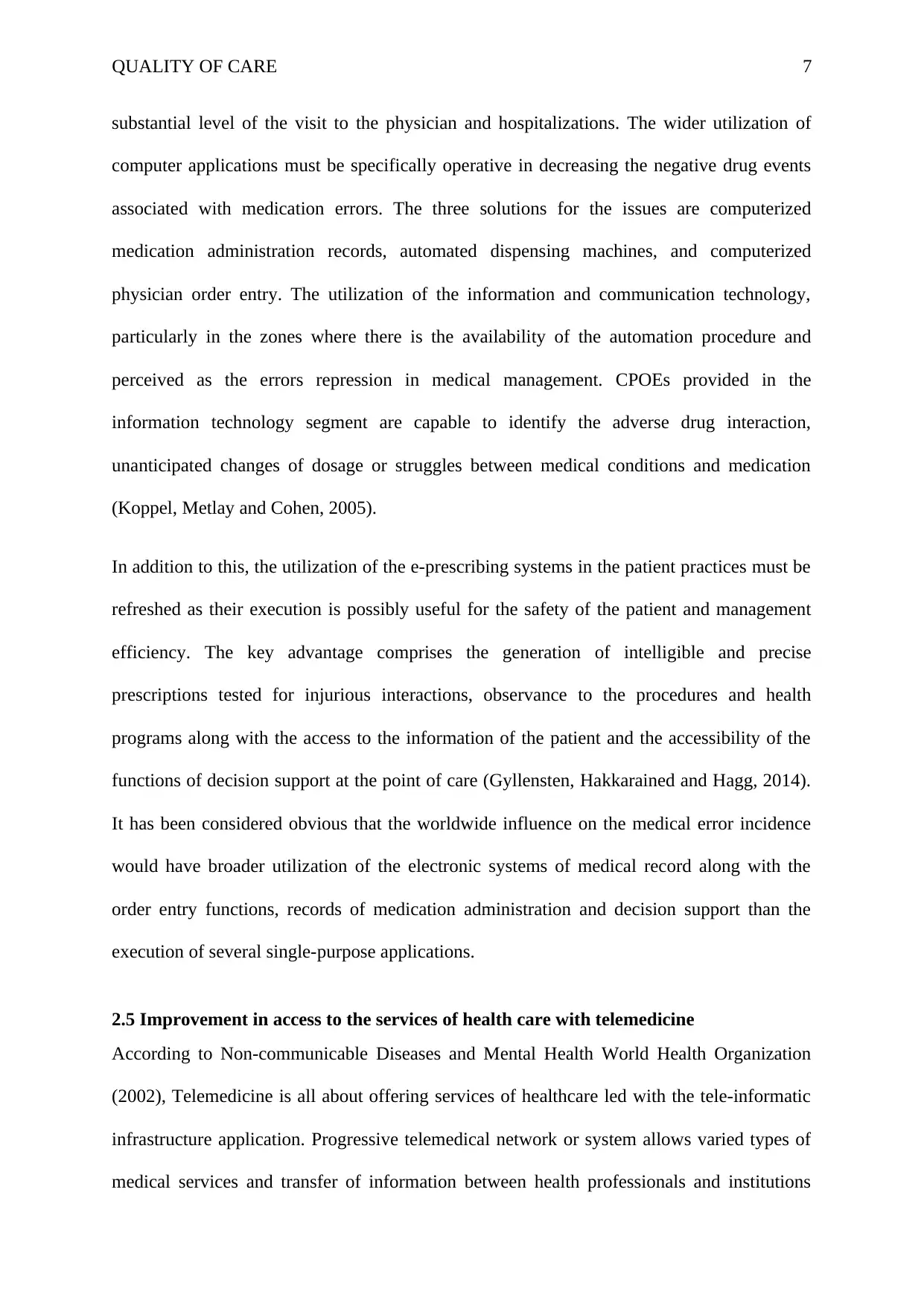
QUALITY OF CARE 7
substantial level of the visit to the physician and hospitalizations. The wider utilization of
computer applications must be specifically operative in decreasing the negative drug events
associated with medication errors. The three solutions for the issues are computerized
medication administration records, automated dispensing machines, and computerized
physician order entry. The utilization of the information and communication technology,
particularly in the zones where there is the availability of the automation procedure and
perceived as the errors repression in medical management. CPOEs provided in the
information technology segment are capable to identify the adverse drug interaction,
unanticipated changes of dosage or struggles between medical conditions and medication
(Koppel, Metlay and Cohen, 2005).
In addition to this, the utilization of the e-prescribing systems in the patient practices must be
refreshed as their execution is possibly useful for the safety of the patient and management
efficiency. The key advantage comprises the generation of intelligible and precise
prescriptions tested for injurious interactions, observance to the procedures and health
programs along with the access to the information of the patient and the accessibility of the
functions of decision support at the point of care (Gyllensten, Hakkarained and Hagg, 2014).
It has been considered obvious that the worldwide influence on the medical error incidence
would have broader utilization of the electronic systems of medical record along with the
order entry functions, records of medication administration and decision support than the
execution of several single-purpose applications.
2.5 Improvement in access to the services of health care with telemedicine
According to Non-communicable Diseases and Mental Health World Health Organization
(2002), Telemedicine is all about offering services of healthcare led with the tele-informatic
infrastructure application. Progressive telemedical network or system allows varied types of
medical services and transfer of information between health professionals and institutions
substantial level of the visit to the physician and hospitalizations. The wider utilization of
computer applications must be specifically operative in decreasing the negative drug events
associated with medication errors. The three solutions for the issues are computerized
medication administration records, automated dispensing machines, and computerized
physician order entry. The utilization of the information and communication technology,
particularly in the zones where there is the availability of the automation procedure and
perceived as the errors repression in medical management. CPOEs provided in the
information technology segment are capable to identify the adverse drug interaction,
unanticipated changes of dosage or struggles between medical conditions and medication
(Koppel, Metlay and Cohen, 2005).
In addition to this, the utilization of the e-prescribing systems in the patient practices must be
refreshed as their execution is possibly useful for the safety of the patient and management
efficiency. The key advantage comprises the generation of intelligible and precise
prescriptions tested for injurious interactions, observance to the procedures and health
programs along with the access to the information of the patient and the accessibility of the
functions of decision support at the point of care (Gyllensten, Hakkarained and Hagg, 2014).
It has been considered obvious that the worldwide influence on the medical error incidence
would have broader utilization of the electronic systems of medical record along with the
order entry functions, records of medication administration and decision support than the
execution of several single-purpose applications.
2.5 Improvement in access to the services of health care with telemedicine
According to Non-communicable Diseases and Mental Health World Health Organization
(2002), Telemedicine is all about offering services of healthcare led with the tele-informatic
infrastructure application. Progressive telemedical network or system allows varied types of
medical services and transfer of information between health professionals and institutions
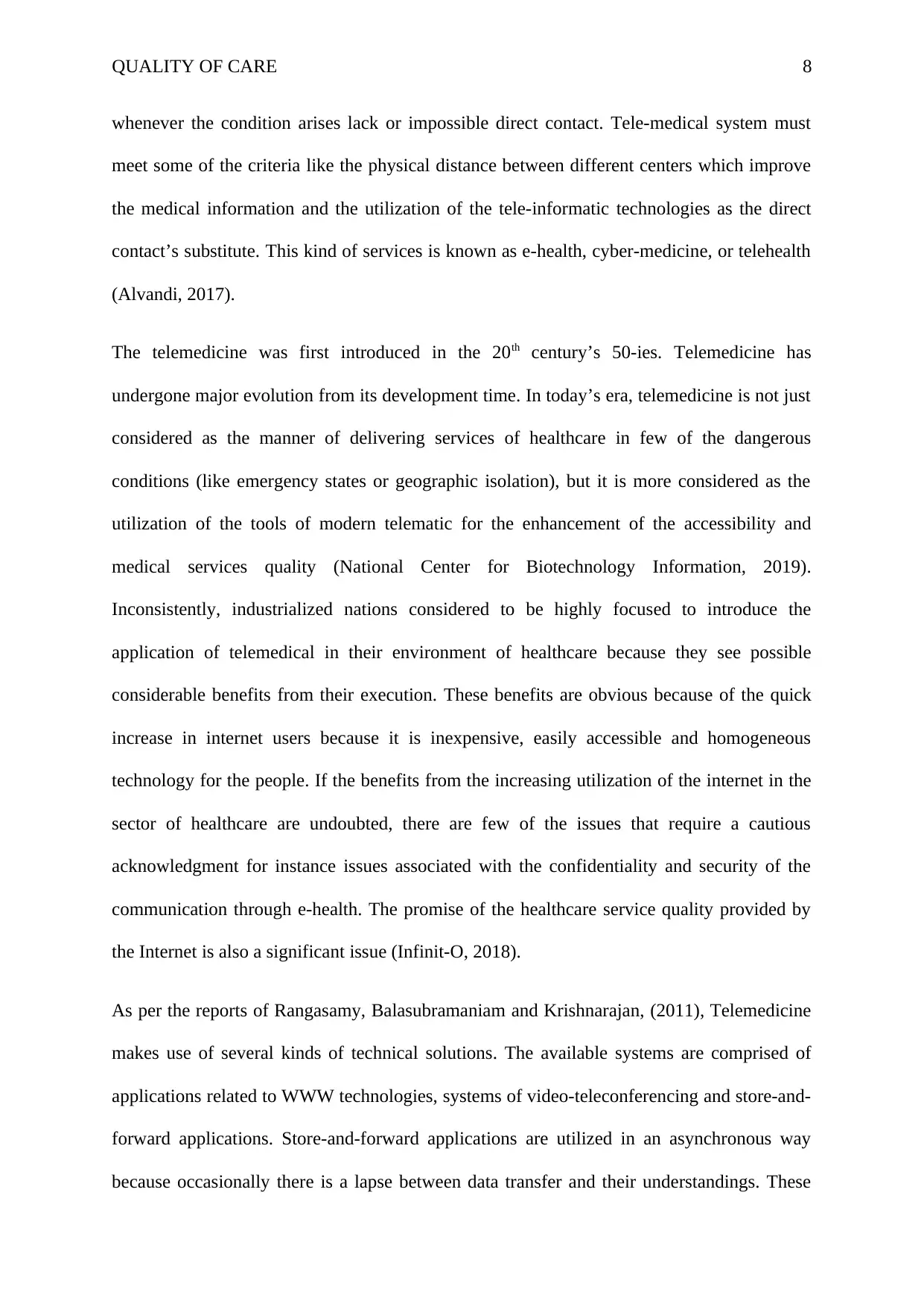
QUALITY OF CARE 8
whenever the condition arises lack or impossible direct contact. Tele-medical system must
meet some of the criteria like the physical distance between different centers which improve
the medical information and the utilization of the tele-informatic technologies as the direct
contact’s substitute. This kind of services is known as e-health, cyber-medicine, or telehealth
(Alvandi, 2017).
The telemedicine was first introduced in the 20th century’s 50-ies. Telemedicine has
undergone major evolution from its development time. In today’s era, telemedicine is not just
considered as the manner of delivering services of healthcare in few of the dangerous
conditions (like emergency states or geographic isolation), but it is more considered as the
utilization of the tools of modern telematic for the enhancement of the accessibility and
medical services quality (National Center for Biotechnology Information, 2019).
Inconsistently, industrialized nations considered to be highly focused to introduce the
application of telemedical in their environment of healthcare because they see possible
considerable benefits from their execution. These benefits are obvious because of the quick
increase in internet users because it is inexpensive, easily accessible and homogeneous
technology for the people. If the benefits from the increasing utilization of the internet in the
sector of healthcare are undoubted, there are few of the issues that require a cautious
acknowledgment for instance issues associated with the confidentiality and security of the
communication through e-health. The promise of the healthcare service quality provided by
the Internet is also a significant issue (Infinit-O, 2018).
As per the reports of Rangasamy, Balasubramaniam and Krishnarajan, (2011), Telemedicine
makes use of several kinds of technical solutions. The available systems are comprised of
applications related to WWW technologies, systems of video-teleconferencing and store-and-
forward applications. Store-and-forward applications are utilized in an asynchronous way
because occasionally there is a lapse between data transfer and their understandings. These
whenever the condition arises lack or impossible direct contact. Tele-medical system must
meet some of the criteria like the physical distance between different centers which improve
the medical information and the utilization of the tele-informatic technologies as the direct
contact’s substitute. This kind of services is known as e-health, cyber-medicine, or telehealth
(Alvandi, 2017).
The telemedicine was first introduced in the 20th century’s 50-ies. Telemedicine has
undergone major evolution from its development time. In today’s era, telemedicine is not just
considered as the manner of delivering services of healthcare in few of the dangerous
conditions (like emergency states or geographic isolation), but it is more considered as the
utilization of the tools of modern telematic for the enhancement of the accessibility and
medical services quality (National Center for Biotechnology Information, 2019).
Inconsistently, industrialized nations considered to be highly focused to introduce the
application of telemedical in their environment of healthcare because they see possible
considerable benefits from their execution. These benefits are obvious because of the quick
increase in internet users because it is inexpensive, easily accessible and homogeneous
technology for the people. If the benefits from the increasing utilization of the internet in the
sector of healthcare are undoubted, there are few of the issues that require a cautious
acknowledgment for instance issues associated with the confidentiality and security of the
communication through e-health. The promise of the healthcare service quality provided by
the Internet is also a significant issue (Infinit-O, 2018).
As per the reports of Rangasamy, Balasubramaniam and Krishnarajan, (2011), Telemedicine
makes use of several kinds of technical solutions. The available systems are comprised of
applications related to WWW technologies, systems of video-teleconferencing and store-and-
forward applications. Store-and-forward applications are utilized in an asynchronous way
because occasionally there is a lapse between data transfer and their understandings. These
⊘ This is a preview!⊘
Do you want full access?
Subscribe today to unlock all pages.

Trusted by 1+ million students worldwide
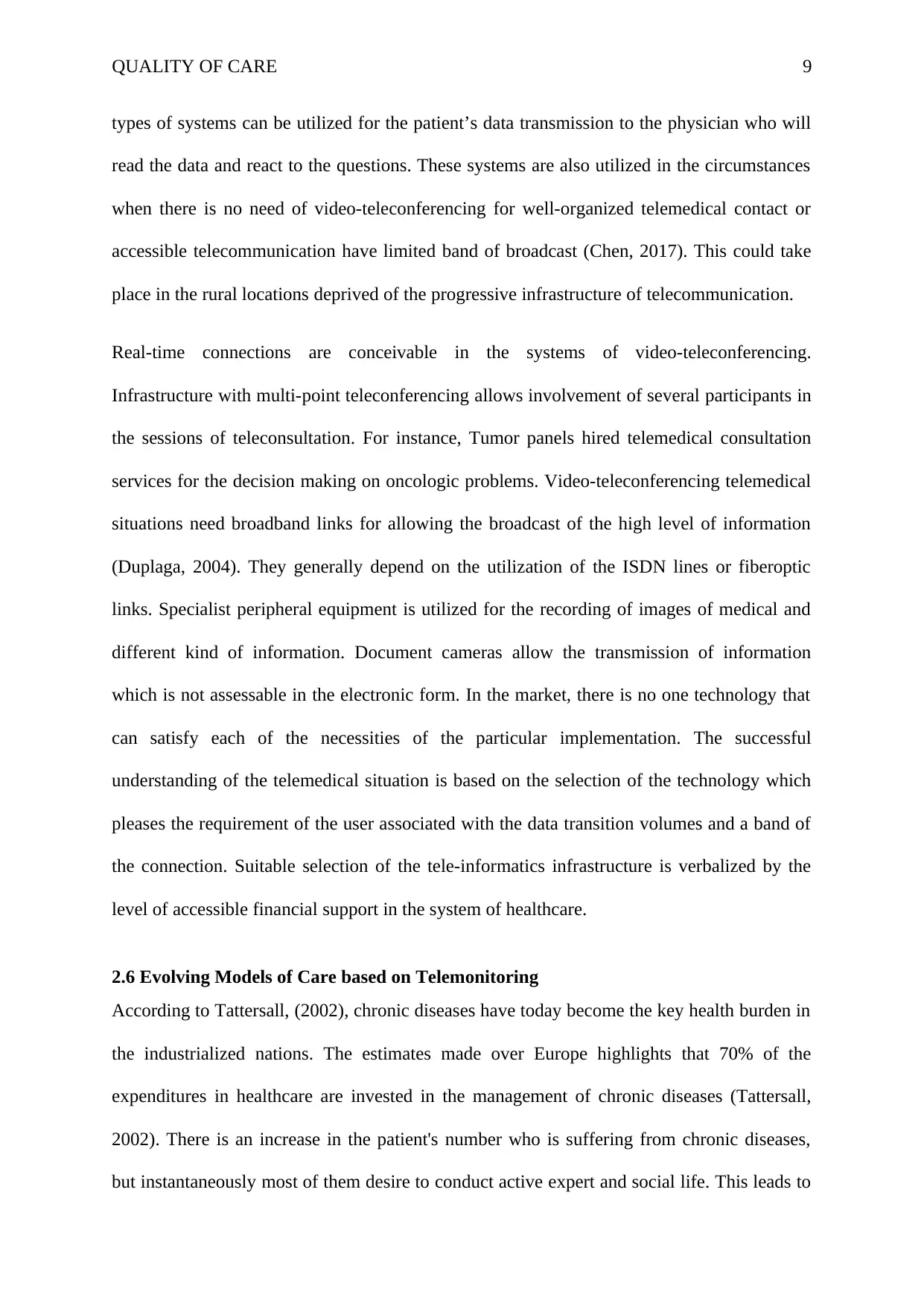
QUALITY OF CARE 9
types of systems can be utilized for the patient’s data transmission to the physician who will
read the data and react to the questions. These systems are also utilized in the circumstances
when there is no need of video-teleconferencing for well-organized telemedical contact or
accessible telecommunication have limited band of broadcast (Chen, 2017). This could take
place in the rural locations deprived of the progressive infrastructure of telecommunication.
Real-time connections are conceivable in the systems of video-teleconferencing.
Infrastructure with multi-point teleconferencing allows involvement of several participants in
the sessions of teleconsultation. For instance, Tumor panels hired telemedical consultation
services for the decision making on oncologic problems. Video-teleconferencing telemedical
situations need broadband links for allowing the broadcast of the high level of information
(Duplaga, 2004). They generally depend on the utilization of the ISDN lines or fiberoptic
links. Specialist peripheral equipment is utilized for the recording of images of medical and
different kind of information. Document cameras allow the transmission of information
which is not assessable in the electronic form. In the market, there is no one technology that
can satisfy each of the necessities of the particular implementation. The successful
understanding of the telemedical situation is based on the selection of the technology which
pleases the requirement of the user associated with the data transition volumes and a band of
the connection. Suitable selection of the tele-informatics infrastructure is verbalized by the
level of accessible financial support in the system of healthcare.
2.6 Evolving Models of Care based on Telemonitoring
According to Tattersall, (2002), chronic diseases have today become the key health burden in
the industrialized nations. The estimates made over Europe highlights that 70% of the
expenditures in healthcare are invested in the management of chronic diseases (Tattersall,
2002). There is an increase in the patient's number who is suffering from chronic diseases,
but instantaneously most of them desire to conduct active expert and social life. This leads to
types of systems can be utilized for the patient’s data transmission to the physician who will
read the data and react to the questions. These systems are also utilized in the circumstances
when there is no need of video-teleconferencing for well-organized telemedical contact or
accessible telecommunication have limited band of broadcast (Chen, 2017). This could take
place in the rural locations deprived of the progressive infrastructure of telecommunication.
Real-time connections are conceivable in the systems of video-teleconferencing.
Infrastructure with multi-point teleconferencing allows involvement of several participants in
the sessions of teleconsultation. For instance, Tumor panels hired telemedical consultation
services for the decision making on oncologic problems. Video-teleconferencing telemedical
situations need broadband links for allowing the broadcast of the high level of information
(Duplaga, 2004). They generally depend on the utilization of the ISDN lines or fiberoptic
links. Specialist peripheral equipment is utilized for the recording of images of medical and
different kind of information. Document cameras allow the transmission of information
which is not assessable in the electronic form. In the market, there is no one technology that
can satisfy each of the necessities of the particular implementation. The successful
understanding of the telemedical situation is based on the selection of the technology which
pleases the requirement of the user associated with the data transition volumes and a band of
the connection. Suitable selection of the tele-informatics infrastructure is verbalized by the
level of accessible financial support in the system of healthcare.
2.6 Evolving Models of Care based on Telemonitoring
According to Tattersall, (2002), chronic diseases have today become the key health burden in
the industrialized nations. The estimates made over Europe highlights that 70% of the
expenditures in healthcare are invested in the management of chronic diseases (Tattersall,
2002). There is an increase in the patient's number who is suffering from chronic diseases,
but instantaneously most of them desire to conduct active expert and social life. This leads to
Paraphrase This Document
Need a fresh take? Get an instant paraphrase of this document with our AI Paraphraser

QUALITY OF CARE 10
the requirement of the enhanced healthcare system efficiency. The role of the patient in the
control of the symptoms and therapy, the significance of the proper follow-up of the patient,
community services and anticipation are not highlighted correctly in the systems of
healthcare as they have served for many years majorly for the care delivery to the patient with
severe illnesses. The utilization of Internet technologies in the delivery of health services
under chronic care carries fresh opportunities and possibly profitable models of care. E-health
environment provides extra characteristics to the contemporary healthcare by shaping new
kind of relation between the experts, doctors, or physicians and patients which allow
automatic screening of the disease exacerbations, and development of the support network for
the patient.
The increase in the patient’s population needing chronic care and nursing became the issue
activating the hunt of profitable but safe health service models. The increasing acceptance of
the Internet in several domains carried the potential for enhancement of the competence of
healthcare offered to the patients that are suffering from chronic diseases. WWW
technologies appear to be mainly practicable to attain a suitable range of interactivity for
chronic patients (Duplaga, 2004). Patient empowerment is all about her/ his participation in
the protracted observations of the disease progression, leading self-measurement of strictures
vital for the definite disease. The main suggestion of self-management under chronic diseases
is dependent on the registration of the self-measurements and self-observations in the long-
run viewpoint. Protracted outlining of physiologic strictures allows the explanation of the
disease and predicting of the exacerbations. Self-measurement and observations can be the
foundation for the automatic activating of signals directed to the professionals of healthcare
and patients. Drift detected in the course of the disease are also the foundation for the
alteration of medication by the patient that is also called as the self-adjusted treatment.
the requirement of the enhanced healthcare system efficiency. The role of the patient in the
control of the symptoms and therapy, the significance of the proper follow-up of the patient,
community services and anticipation are not highlighted correctly in the systems of
healthcare as they have served for many years majorly for the care delivery to the patient with
severe illnesses. The utilization of Internet technologies in the delivery of health services
under chronic care carries fresh opportunities and possibly profitable models of care. E-health
environment provides extra characteristics to the contemporary healthcare by shaping new
kind of relation between the experts, doctors, or physicians and patients which allow
automatic screening of the disease exacerbations, and development of the support network for
the patient.
The increase in the patient’s population needing chronic care and nursing became the issue
activating the hunt of profitable but safe health service models. The increasing acceptance of
the Internet in several domains carried the potential for enhancement of the competence of
healthcare offered to the patients that are suffering from chronic diseases. WWW
technologies appear to be mainly practicable to attain a suitable range of interactivity for
chronic patients (Duplaga, 2004). Patient empowerment is all about her/ his participation in
the protracted observations of the disease progression, leading self-measurement of strictures
vital for the definite disease. The main suggestion of self-management under chronic diseases
is dependent on the registration of the self-measurements and self-observations in the long-
run viewpoint. Protracted outlining of physiologic strictures allows the explanation of the
disease and predicting of the exacerbations. Self-measurement and observations can be the
foundation for the automatic activating of signals directed to the professionals of healthcare
and patients. Drift detected in the course of the disease are also the foundation for the
alteration of medication by the patient that is also called as the self-adjusted treatment.
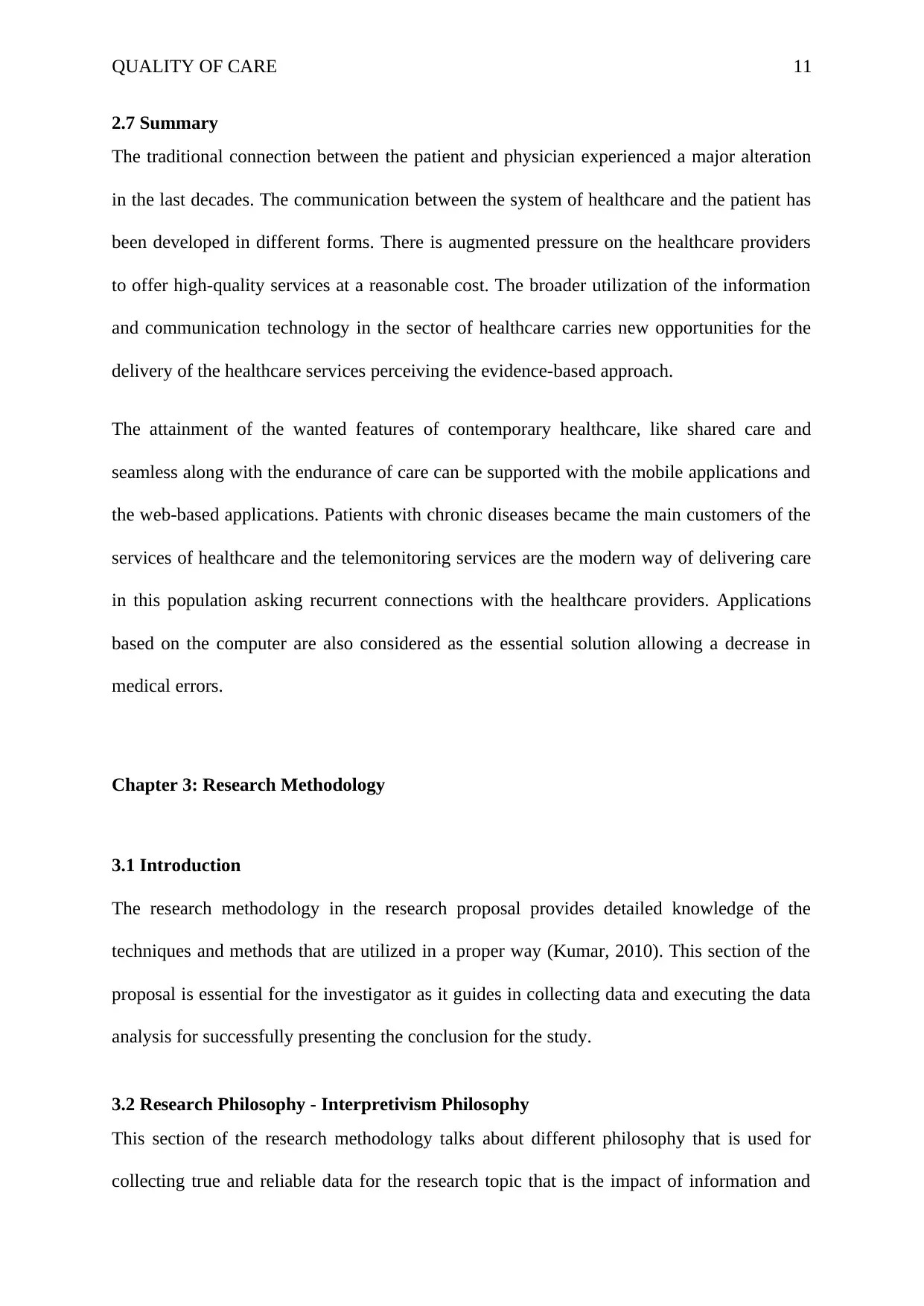
QUALITY OF CARE 11
2.7 Summary
The traditional connection between the patient and physician experienced a major alteration
in the last decades. The communication between the system of healthcare and the patient has
been developed in different forms. There is augmented pressure on the healthcare providers
to offer high-quality services at a reasonable cost. The broader utilization of the information
and communication technology in the sector of healthcare carries new opportunities for the
delivery of the healthcare services perceiving the evidence-based approach.
The attainment of the wanted features of contemporary healthcare, like shared care and
seamless along with the endurance of care can be supported with the mobile applications and
the web-based applications. Patients with chronic diseases became the main customers of the
services of healthcare and the telemonitoring services are the modern way of delivering care
in this population asking recurrent connections with the healthcare providers. Applications
based on the computer are also considered as the essential solution allowing a decrease in
medical errors.
Chapter 3: Research Methodology
3.1 Introduction
The research methodology in the research proposal provides detailed knowledge of the
techniques and methods that are utilized in a proper way (Kumar, 2010). This section of the
proposal is essential for the investigator as it guides in collecting data and executing the data
analysis for successfully presenting the conclusion for the study.
3.2 Research Philosophy - Interpretivism Philosophy
This section of the research methodology talks about different philosophy that is used for
collecting true and reliable data for the research topic that is the impact of information and
2.7 Summary
The traditional connection between the patient and physician experienced a major alteration
in the last decades. The communication between the system of healthcare and the patient has
been developed in different forms. There is augmented pressure on the healthcare providers
to offer high-quality services at a reasonable cost. The broader utilization of the information
and communication technology in the sector of healthcare carries new opportunities for the
delivery of the healthcare services perceiving the evidence-based approach.
The attainment of the wanted features of contemporary healthcare, like shared care and
seamless along with the endurance of care can be supported with the mobile applications and
the web-based applications. Patients with chronic diseases became the main customers of the
services of healthcare and the telemonitoring services are the modern way of delivering care
in this population asking recurrent connections with the healthcare providers. Applications
based on the computer are also considered as the essential solution allowing a decrease in
medical errors.
Chapter 3: Research Methodology
3.1 Introduction
The research methodology in the research proposal provides detailed knowledge of the
techniques and methods that are utilized in a proper way (Kumar, 2010). This section of the
proposal is essential for the investigator as it guides in collecting data and executing the data
analysis for successfully presenting the conclusion for the study.
3.2 Research Philosophy - Interpretivism Philosophy
This section of the research methodology talks about different philosophy that is used for
collecting true and reliable data for the research topic that is the impact of information and
⊘ This is a preview!⊘
Do you want full access?
Subscribe today to unlock all pages.

Trusted by 1+ million students worldwide
1 out of 21
Related Documents
Your All-in-One AI-Powered Toolkit for Academic Success.
+13062052269
info@desklib.com
Available 24*7 on WhatsApp / Email
![[object Object]](/_next/static/media/star-bottom.7253800d.svg)
Unlock your academic potential
Copyright © 2020–2025 A2Z Services. All Rights Reserved. Developed and managed by ZUCOL.





